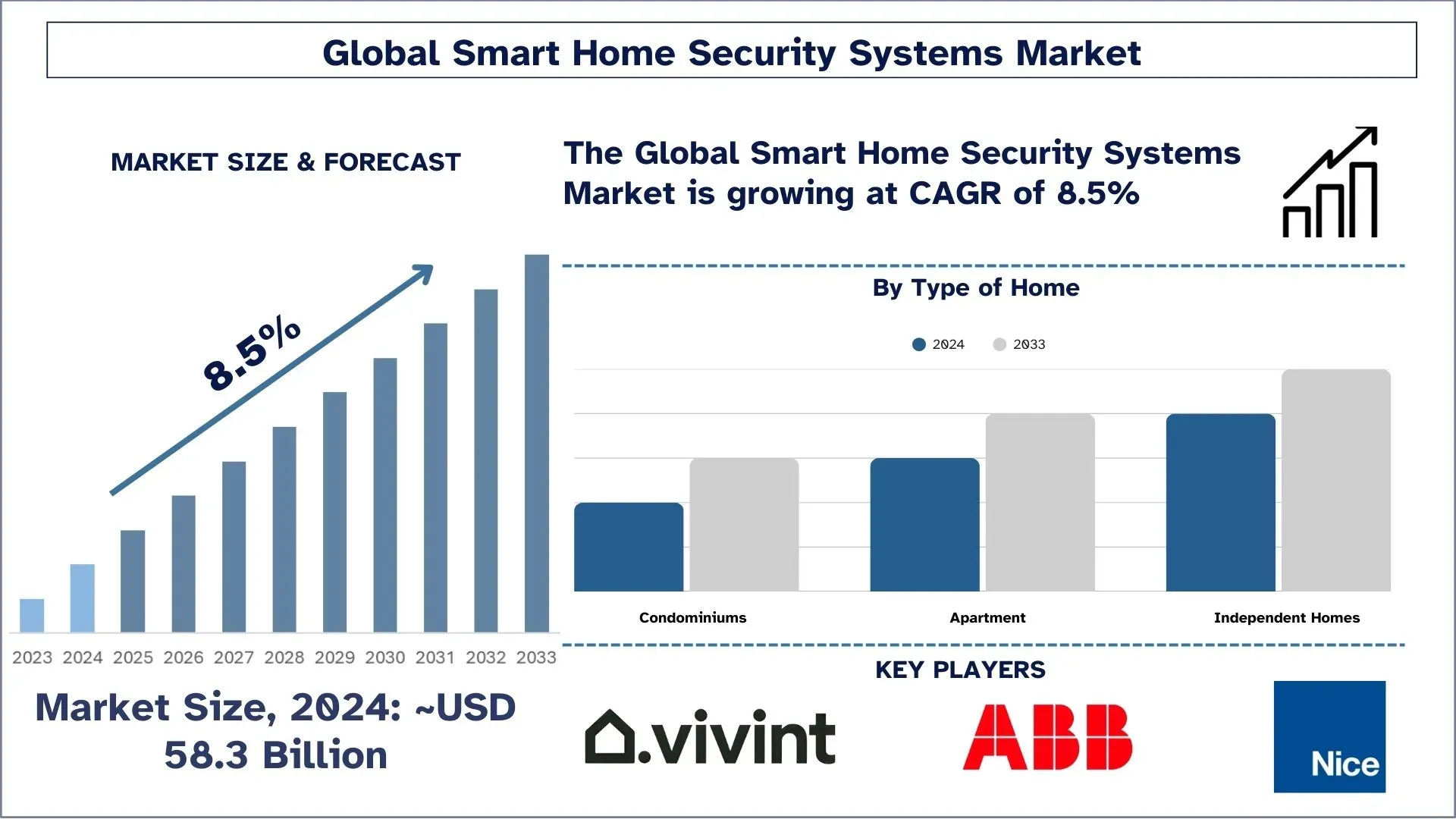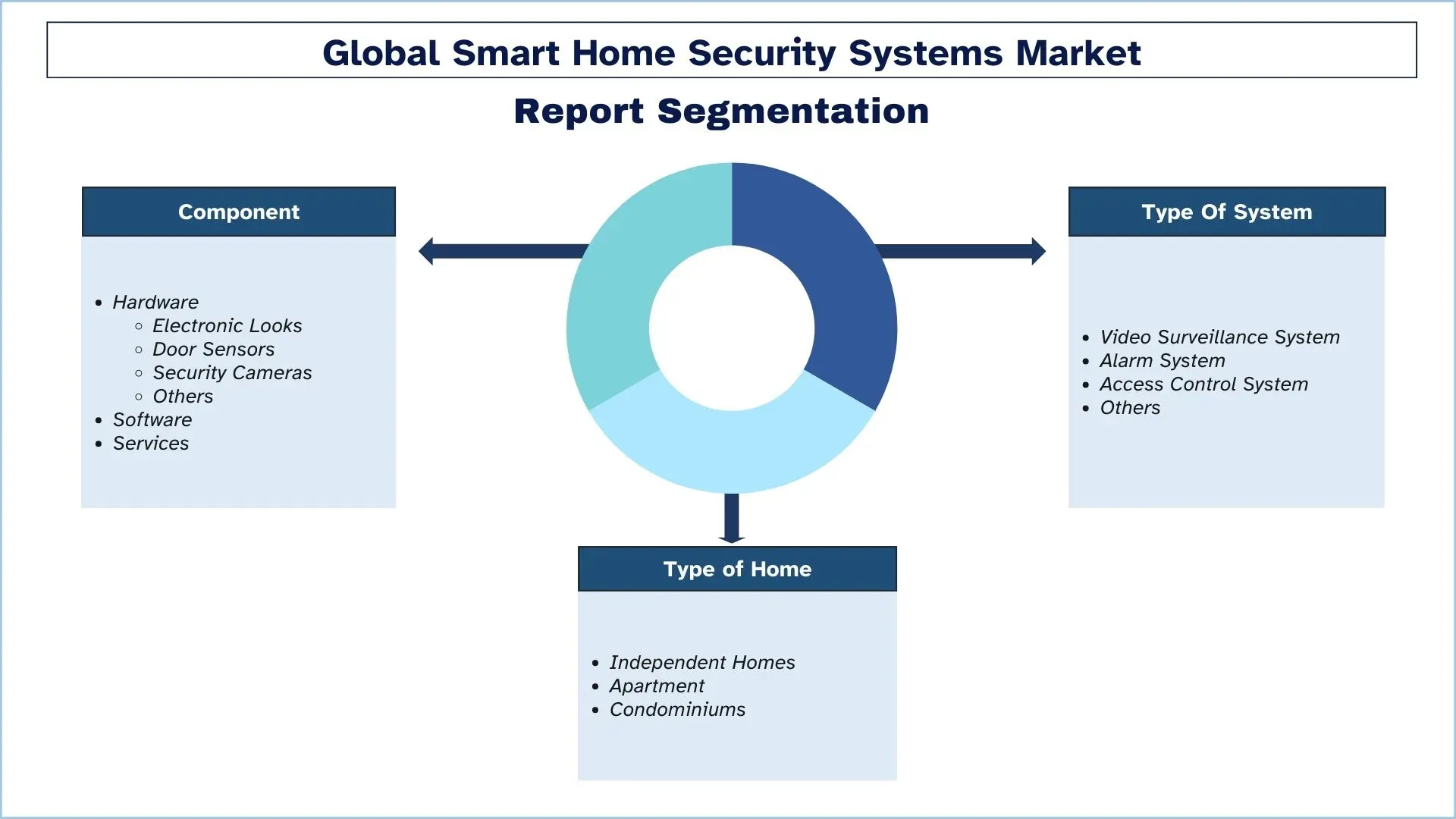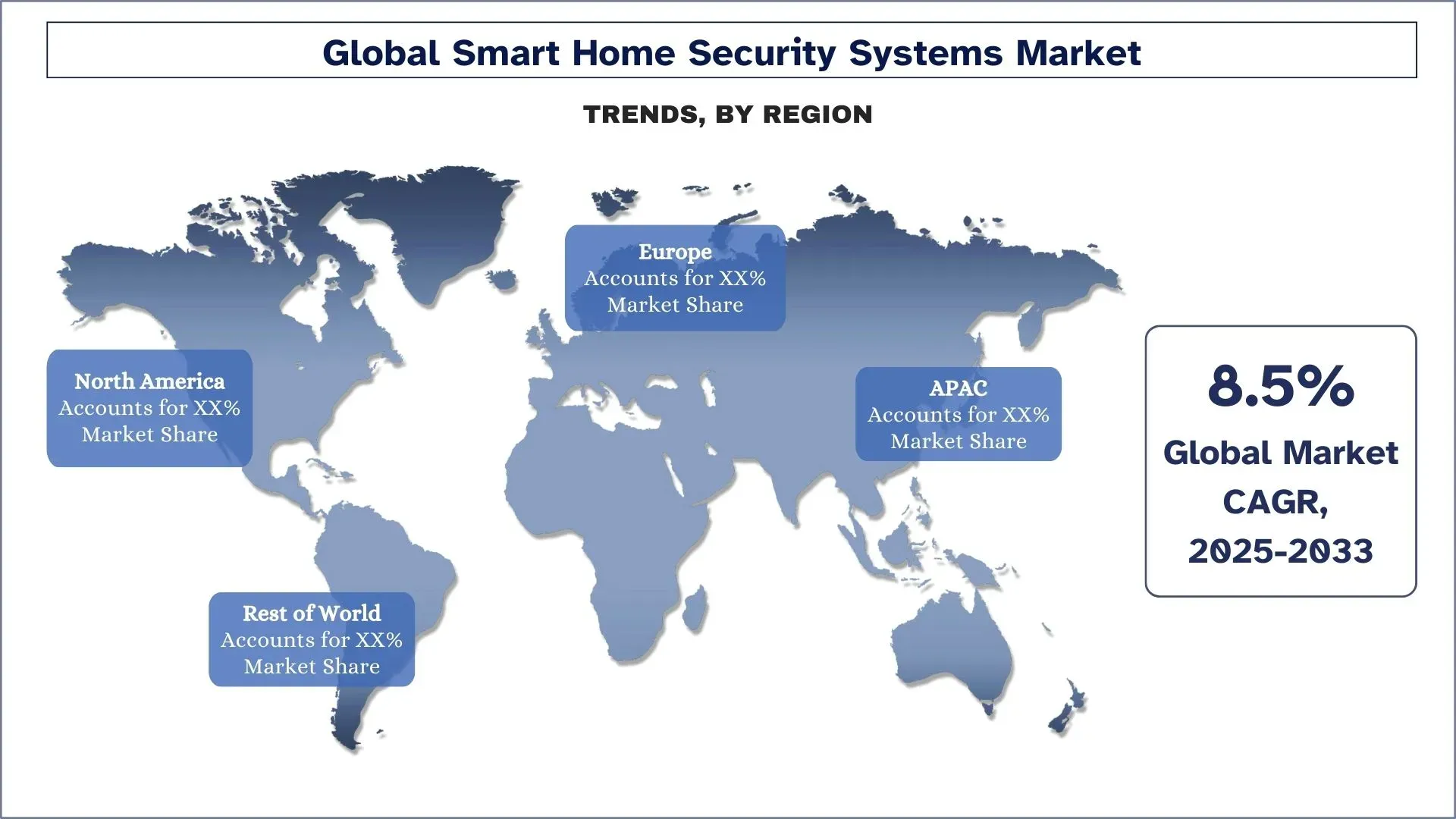- Home
- About Us
- Industry
- Services
- Reading
- Contact Us
Smart Home Security Systems Market: Current Analysis and Forecast (2025-2033)
Component (hardware {electronic looks, door sensors, security cameras, others}, software, services), Type of system (video surveillance system, alarm system, access control system, others), Type of Home (independent homes, apartment, condominiums) and Region/Country

Smart Home Security Systems Market Size & Forecast
The Smart Home Security Systems Market was valued at approximately USD 58.3 billion in 2024 and is expected to grow at a substantial CAGR of around 8.5% during the forecast period (2025-2033), owing to the rising awareness about home safety.
Smart Home Security Systems Market Analysis
Smart home security systems are a type of home security solution that allows homeowners to monitor and control their homes remotely using their smartphones, tablets, or computers. These systems use various devices, such as cameras, sensors, and smart locks, to detect and prevent unauthorized access or activities in and around the home. Furthermore, Smart home security systems are convenient because they allow homeowners to monitor their homes remotely. This means that they can check on their homes from anywhere, using a smartphone or other mobile device. They can also receive alerts if there is any unusual activity in their homes. Moreover, the smart home security systems market in North America is a rapidly growing industry. With the increasing adoption of smart home technologies and the rise in security concerns among consumers, the demand for smart home security systems has been steadily increasing.
Smart Home Security Systems Market Trends
This section discusses the key market trends influencing the various segments of the Smart Home Security Systems market as identified by our research experts.
AI and IoT Integration Enhancing Smart Home Security.
The smart home security systems are receiving major changes for the integration of AI and IoT technology. Owners of surveillance cameras can now be able to distinguish between real risks and mere triggers, hence improving the user experience. Biometrics, such as a face and voice, allow the supporting infrastructure to recognize people known by the homeowner, and even warn about intruders. Using identifying trends in people’s actions and the possible threats that could arise, predictive analytics may predict incidents in advance. In addition, AI enables the smart home devices, for instance, locks, lights, and alarms, to install security systems to provide an expected emergency response when required. These effectively not only optimally enhance the functionalities and effectiveness of home security systems but also allow their users more ease and security.
Smart Home Security Systems Market Industry Segmentation
This section provides an analysis of the key trends in each segment of the global Smart Home Security Systems market report, along with forecasts at the global, regional, and country levels for 2025-2033.
The Software Segment is Expected to Witness a Higher CAGR than the Smart Home Security Systems Market.
Based on component, the market is segmented into hardware, software, and services. Hardware is further segmented into electronic locks, door sensors, security cameras, and others. Among these, the software segment is expected to grow at the fastest rate during the forecast period. The software segment in the smart home security systems market refers to the various programs and applications that are used to manage and control the security devices installed in a smart home. Moreover, the basic functionality of managing and controlling security devices, many smart home security software programs offer advanced features such as facial recognition, voice recognition, and machine learning algorithms that can help to identify potential threats and respond accordingly.
The Video Surveillance System Market Holds the Largest Share of the Market.
Based on the type of system, the market is categorized into video surveillance system, alarm system, access control system, and others. Among these, the video surveillance system held a significant share in the market in 2022. One of the primary reasons video surveillance systems hold a significant share in the smart home security system market is their versatility. Video surveillance systems can be tailored to fit the specific needs of individual homeowners, including indoor and outdoor cameras, high-resolution footage, and remote access through a mobile app or web portal. Additionally, many video surveillance systems now incorporate advanced features such as facial recognition, motion detection, and automatic alerts, which allow homeowners to quickly respond to potential security threats.

North America has a significant share of the market in 2024.
North America is known for its innovative and technologically advanced industries, which continue to drive growth in the region. The adoption of advanced technologies such as artificial intelligence, the Internet of Things (IoT), and automation is expected to contribute significantly to the growth of North America’s economy. Moreover, it has a business-friendly regulatory environment that encourages entrepreneurship and innovation. The region’s governments have implemented policies and initiatives aimed at attracting investment and promoting economic growth. The region’s strong economy, coupled with its highly skilled workforce, makes it an attractive destination for businesses looking to expand their operations. Furthermore, North America’s favorable business environment, technological advancement, and robust infrastructure make it an attractive region for investment and growth.
U.S. Dominates the North American Smart Home Security Systems Market
The United States reigns supreme in the smart home security systems market due to growing perils at homes and the popularity of technologically enhanced devices. Approximately 94 million U.S. households utilize some form of security system, including cameras, alarms, or access control tools. Moreover, the following drivers have been obtained to explain the growth in this industry: real-time threat detection, enhanced monitoring, and forecasting. Moreover, the further connection of smart home security systems with voice assistants like Amazon Alexa and Google Assistant is making the products steadily popular with consumers. However, issues that are present here include concerns about the privacy of data and challenges that arise from the integration of new systems with home infrastructure.

Smart Home Security Systems Market Industry Competitive Landscape
The Smart Home Security Systems market is competitive, with several global and international players. The key players are adopting different growth strategies to enhance their market presence, such as partnerships, agreements, collaborations, new product launches, geographical expansions, and mergers and acquisitions.
Top Smart Home Security Systems Market Companies
Some of the major players operating in the market are ABB; Nice North America LLC; Vivint, Inc.; SimpliSafe, Inc.; ADT LLC; Cove Smart, LLC; Abode systems, Inc.; Frontpoint Security Solutions; Arlo; Wyze Labs. Inc.
Recent Developments in the Smart Home Security Systems Market
- March 2023: ADT launched the latest ADT Self-Setup Smart Home Security System, which is a completely integrated DIY offering and an enhanced DIY system from Google and ADT. The new system provides convenient control of the new ADT+ app by integrating Google Nest smart home products with ADT life safety and security technologies, as well as SMART monitoring.
- February 2023: Costco partnered with ADT to offer packages with a 13 and 9-piece system, both of which include Google Nest products. Professional installation and ADT's SMART monitoring are also part of these packages.
Smart Home Security Systems Market Report Coverage
Details | |
Base year | 2024 |
Forecast period | 2025-2033 |
Growth momentum | Accelerate at a CAGR of 8.5% |
Market size 2024 | USD 58.3 Billion |
Regional analysis | APAC, Europe, Asia-Pacific, Rest of the World |
Major contributing region | North America is expected to grow at the highest CAGR during the forecasted period. |
Key countries covered | U.S., Canada, Germany, France, UK, Spain, Italy, China, Japan, and India |
ABB; Nice North America LLC; Vivint, Inc.; SimpliSafe, Inc.; ADT LLC; Cove Smart, LLC; Abode systems, Inc.; Frontpoint Security Solutions; Arlo; Wyze Labs. Inc. | |
Report Scope | Market Trends, Drivers, and Restraints; Revenue Estimation and Forecast; Segmentation Analysis; Demand and Supply Side Analysis; Competitive Landscape; Company Profiling |
Segments Covered | By Component, By Type of System, By Type of Home, By Region/Country |
Reasons to Buy the Smart Home Security Systems Market Report:
- The study includes market sizing and forecasting analysis validated by authenticated key industry experts.
- The report presents a quick review of overall industry performance at a glance.
- The report covers an in-depth analysis of prominent industry peers with a primary focus on key business financials, product portfolios, expansion strategies, and recent developments.
- Detailed examination of drivers, restraints, key trends, and opportunities prevailing in the industry.
- The study comprehensively covers the market across different segments.
- Deep dive regional-level analysis of the industry.
Customization Options:
The global Smart Home Security Systems Market can be customized further as per the requirements or any other market segment. Besides this, UnivDatos understands that you may have your own business needs; hence, feel free to contact us to get a report that completely suits your requirements.
Table of Content
Research Methodology for Smart Home Security Systems Market Analysis (2023-2033)
We analyzed the historical market, estimated the current market, and forecasted the future market of the global Smart Home Security Systems Market to assess its application in major regions worldwide. We conducted exhaustive secondary research to gather historical market data and estimate the current market size. To validate these insights, we carefully reviewed numerous findings and assumptions. Additionally, we conducted in-depth primary interviews with industry experts across the Smart Home Security Systems Market value chain. After validating market figures through these interviews, we used top-down and bottom-up approaches to forecast the overall market size. We then employed market breakdown and data triangulation methods to estimate and analyze the market size of industry segments and sub-segments.
Market Engineering
We employed data triangulation techniques to finalize the overall market estimation and derive precise statistical numbers for each segment and sub-segment of the global Smart Home Security Systems Market. We split the data into several segments and sub-segments by analyzing various parameters and trends, including component, type of system, type of home, and regions within the global Smart Home Security Systems Market.
The main objective of the Global Smart Home Security Systems Market Study
The study identifies current and future trends in the global Smart Home Security Systems Market, providing strategic insights for investors. It highlights regional market attractiveness, enabling industry participants to tap into untapped markets and gain a first-mover advantage. Other quantitative goals of the studies include:
- Market Size Analysis: Assess the current and forecast market size of the global Smart Home Security Systems Market and its segments in terms of value (USD).
- Smart Home Security Systems Market Segmentation: The study segments the market by component, type of system, type of home, and region.
- Regulatory Framework & Value Chain Analysis: Examine the regulatory framework, value chain, customer behavior, and competitive landscape of the Smart Home Security Systems Market industry.
- Regional Analysis: Conduct a detailed regional analysis for key areas such as Asia Pacific, Europe, North America, and the Rest of the World.
- Company Profiles & Growth Strategies: Company profiles of the Smart Home Security Systems Market and the growth strategies adopted by the market leaders to sustain the fast-growing market.
Frequently Asked Questions FAQs
Q1: What is the Smart Home Security Systems market's current size and growth potential?
As of 2024, the global smart home security systems market is valued at approximately USD 58.3 billion and is projected to grow at a CAGR of 8.5% through 2033.
Q2: What are the driving factors for the growth of the Smart Home Security Systems market?
Rising concerns over thefts, break-ins, and personal safety are driving the adoption of smart home security systems, especially in urban areas.
Q3: Which market has the largest share of the Smart Home Security Systems market by Type of Home?
The software segment dominates the global Smart Home Security Systems market by type of home segment.
Q4: What are the major trends in the Smart Home Security Systems market?
Smart security systems are increasingly incorporating AI-powered analytics, facial recognition, and IoT connectivity for real-time monitoring and predictive threat detection.
Q5: Which region will dominate the Smart Home Security Systems market?
The North America region currently dominates the global Smart Home Security Systems Market.
Q6: What are the biggest challenges in the Smart Home Security Systems market?
The upfront investment and ongoing maintenance expenses remain barriers for widespread adoption, particularly in cost-sensitive markets.
Q7: Who are the Top players in the global Smart Home Security Systems market?
The leading companies driving innovation in the Smart Home Security Systems market include:
• ABB
• Nice North America LLC
• Vivint, Inc.
• SimpliSafe, Inc.
• ADT LLC
• Cove Smart, LLC
• Abode systems, Inc.
• Frontpoint Security Solutions
• Arlo
• Wyze Labs, Inc
Q8: How is artificial intelligence (AI) transforming the smart home security systems market?
AI is enabling smarter threat detection, reducing false alarms, and allowing personalized monitoring through features like facial recognition and behavior-based alerts, which improves system efficiency and customer experience.
Q9: What are key factors to consider when entering the smart home security market?
Businesses should consider factors such as integration capabilities with other smart devices, data privacy regulations, consumer pricing sensitivity, and the rising demand for mobile app-controlled security systems.
Related Reports
Customers who bought this item also bought










